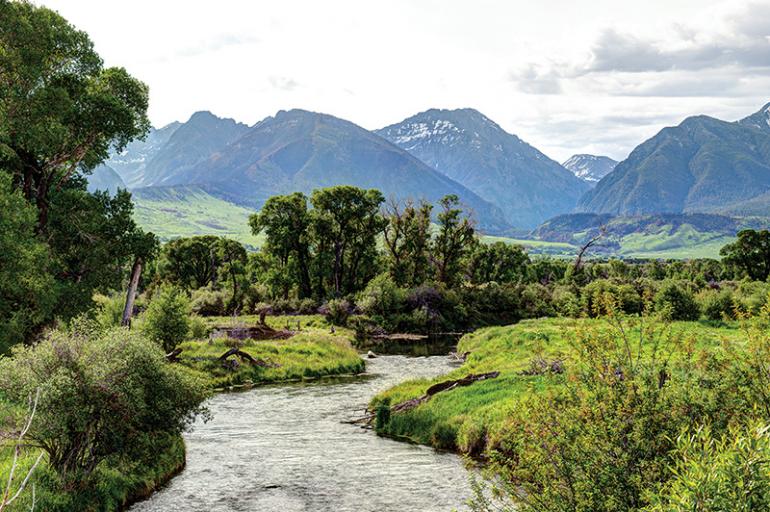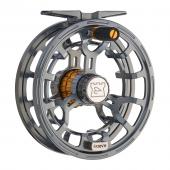Clear Water Act
Where to fish during spring runoff.
At long last, spring is here. Those bright, clear days, the warm sun on your vitamin D-deprived skin, finally exposed to light and air after a lengthy sequestration under layers of wool and fleece. You feel a pull, strong, familiar, inexorable, to the river… you give yourself over to it and you rig your rod and you float, like a cottonwood tuft in the wind, down to your favorite fishing hole—and your heart sinks. That tranquil, fish-filled stream in your mind’s eye is gone, replaced by a torrent of mud.
And so the season becomes a countdown, a careful logging of weeks, like a prisoner notching his cell wall: waiting, waiting, and more waiting, until the Gallatin and the Yellowstone clear up, and you can spend your evenings and weekends on the water, where iridescent trout rise to fluttering bugs, where deer browse and muskrats wander, where you belong, where all seems right with the world.
Good news, friend: the wait is over. Between tailwaters and spring creeks, there’s plenty to keep you busy, if not downright satisfied, from the first warm day in March till the snowmelt subsides in June. Here’s a rundown on where to fish, and how to fish, until that honey-hole of yours is clear and trout-laden once again.
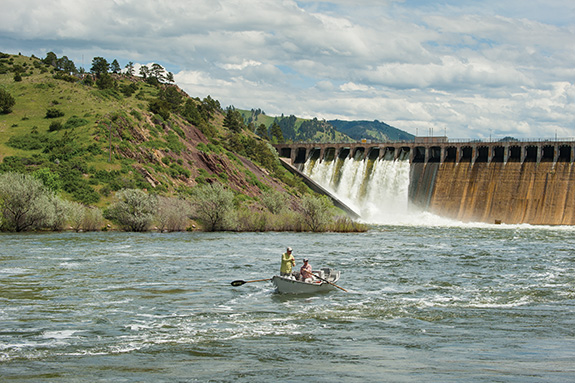
Missouri River, below Holter Dam
Tailwater Tour
by Josh Bergan
There is always somewhere to fish in southwest Montana. During spring runoff, for example, tailwaters (sections of rivers below dams) often remain fishable—some even fish better at this time. Tailwaters still have higher-than-normal flows, generally, but retain enough visibility for fish to see your flies. And while these high flows can make it harder to get your flies deep and can make wading more difficult, they also push trout out of their normal feeding lies and concentrate them in the edges. On the Madison River below the Ennis dam, for example, anglers should focus on the soft water at the edges (eddies, slow spots behind rocks, along the banks, near vegetation, etc.), where trout find respite from the more intense mid-river flow. Here are a few tailwater fisheries to target this spring.
Half-Day Trips
As mentioned above, the Madison below the Ennis dam, known as the Lower Madison, is a great option when other rivers are muddy. There are two main spots for access: directly below the dam, where Bear Trap Canyon begins; and about nine miles downstream, where Hwy. 84 / Norris Rd. abuts the river.
The dam section has a few parking areas, but foot access is impeded by the powerhouse, so only a couple of miles of river are accessible. Downstream near the highway, there are several access points, including the Bear Trap Canyon trailhead, Warm Springs, Canaday, Damselfly, and Black’s Ford. Floating is viable in this slow, flat stretch of river, and an abundance of public land makes wade-access easy. Check fly-shop reports if you want to hit the epic and legendary Mother’s Day caddis hatch on this stretch of river.
An additional close-to-Bozeman option is Hyalite Creek below Hyalite Reservoir. The fishing is usually more about small rainbows and cutthroat than hefty browns and ‘bows, but it’s in a beautiful canyon with abundant access. Be advised that Hyalite Canyon Rd. is closed to vehicles from April 1 to May 16.
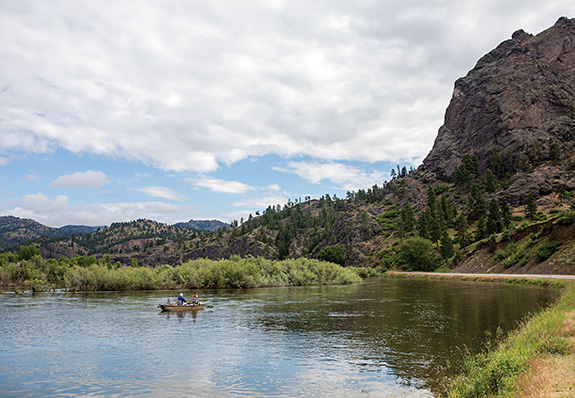
Missouri River
Full-Day Trips
The Madison River below Hebgen Lake is another great tailwater to try during runoff. The famous Upper Madison is one of Montana’s best trout fisheries with its abundance of 15-inch-plus browns and rainbows. As such, it’s also one of the busiest, especially once word has gotten out about active fish or a significant hatch. Access is great, with plenty of official access sites for parking, wading, and launching boats.
A ways beyond that is the Beaverhead River, which starts at Clark Canyon Dam about 20 miles southwest of Dillon. This tremendous fishery is relatively small, but it hosts good numbers of hefty rainbows and browns, and sees (somewhat) fewer anglers than the Madison. The Beaverhead offers good springtime hatches of baetis, midges, and caddis, and don’t be shy about throwing streamers. If runoff is in full effect, stay upstream of Grasshopper Creek. (Note: unlike most other rivers in southwest Montana, the upper Beaverhead is closed for fishing until the third Friday in May.) Poindexter Slough, a tributary about four miles south of Dillon, is comprised of natural spring water combined with a channel of the Beaverhead and fishes well with clear flows.
If a trip over the Continental Divide is on the table, the upper Clark Fork below the Anaconda Settling Ponds can be fun. The Clark Fork is a large river where it exits Montana, but here spans only about the width of a gravel road. It has historically held very large browns and rainbows, but recent surveys indicate only a small number of 20-inch rainbows remain (these fish likely spilled through the dam from the ponds). But good numbers of browns up to 15 inches should keep you busy. Remember that once you’re across the divide, the rules change, so check the FWP regs before heading out.
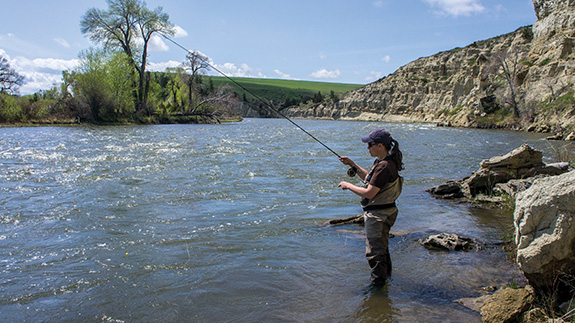
Lower Madison
Weekend Trips
Although the Missouri River headwaters are only a half-hour from Bozeman, the Mighty Mo’s best trout fishing exists downstream, below Holter Dam near the towns of Wolf Creek and Craig. Although you can certainly day-trip to the Missouri from Bozeman, it’s best to stay overnight and spend some time correcting all the mistakes you made the day before. Plus, the apres-angling food, drink, and banter at the local bars is not to be missed.
Another of Montana’s premier trout fisheries, this wide river is best fished from a driftboat, though wade fishing is possible around access sites. Dry-fly fishing can be excellent with thick midge and blue-winged olive emergences, and nymphing with scuds and sowbugs almost always works (if you’ve mastered your Missouri River mending, anyhow). Long-term average trout-per-mile estimates are about 3,400 for rainbows and about 500 for browns. These trout also average about 16 inches. Cabins rentals are available through the fly shops, and camping is allowed at some public access sites.
If you’ve got time for a longer trip, another great weekend option is the Bighorn River below Yellowtail Dam. As with the Missouri, spring is a great time to catch some of the Bighorn’s larger browns and rainbows on scuds and sowbugs, and also fish a strong baetis or midge hatch. There are a handful of lodging options in and around Fort Smith, most of which are all-inclusive resorts, providing meals and guided trips in addition to rooms. A small handful of private and public campgrounds do exist, but be sure to bring your own food and drink, as there’s no guarantee that the one public restaurant and one grocery store will be open. Fort Smith is a tiny hamlet smack-dab in the middle of the massive and wide-open Crow Reservation, with a single road in from Harden, 40 miles to the north. Both Rez rules and small-town customs apply.
Spring Break
by Stephanie Schmeiding
The sun peeked out from behind the clouds, illuminating some colors that caught my eye.
Is that a stick or a fish? Oh wait, I just saw it move. It’s a brown!
Specks of brown, red, and a yellowish-gold reflected back at me as I watched the trout inspect my fly.
This type of fishing is new to me. I’ve never been able to see the fish I’m about to nab.
Breathe, but don’t move a muscle. Stop looking at the fish and watch that indicator!
Before I know it, the indicator drops below the surface. I set the hook, holding my breath in anticipation of an exciting fight.
Wooosh. A stick upstream of the fish shoots through the water, my fly stuck to one side. I spit out a sigh as my prized 18-inch trout spooks and retreats under the bank. Damn.
This is one of the many frustrations that comes with spring-creek fishing, which offers some of the most challenging conditions in the world. That being said, fishermen travel long and far to reap the commensurate benefits that spring creeks offer: monster trout, incredible views, and hatches that can ruin you for any other spot.
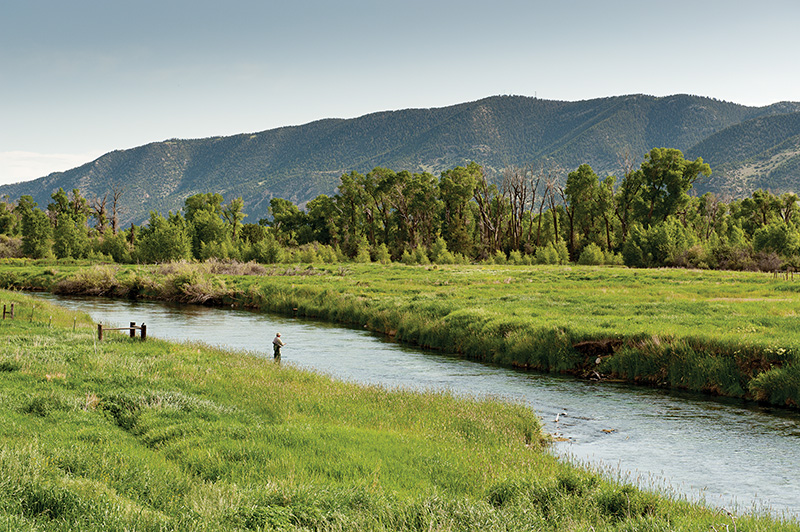
Armstrong Spring Creek
Spring creeks originate from underground aquifers and flow cold year-round. The biomass in the creeks serves as a consistent buffet for high densities of trout. This sounds like a perfect scenario, and it is—except for the crystal-clear water, which requires nothing less than ninja-like stealth and a perfect hatch match.
Think you’re ready for the challenge? Luckily, southwest Montana provides some fantastic spring-creek fishing just a short drive from downtown Bozeman.
Depuy Spring Creek
Nestled between the Absaroka and Gallatin ranges, this Paradise Valley stream provides spectacular views in addition to a bounty of trout. DePuy is just one of the Holy Trinity of spring creeks near Livingston, the others being Nelson’s and Armstrong. But at approximately three miles in length, Depuy allows you to cover the most water—provided it’s a slow day. Depuy’s allows 16 rods per day.
The DePuy family acquired the land in 1905, where they built a home and a fish hatchery. The hatchery, however, was short-lived. A highway was constructed near the main entrance and the existing creek was dredged to add a series of features that make up the waterway today. Nowadays, for a fee, anglers can fish riffles, runs, pools, deep-water pockets, and even the pond near the main house.
One of my favorite parts about DePuy is the set of three warming huts built along the creek, allowing you to take a much-needed break to warm your hands and eat some grub during those sudden early-spring snowstorms. Trust me, it’s necessary.
Spring can bring midge, baetis, caddis, and scattered callibaetis hatches. Off-season rod fees are $40 until April 15th and $80 until June 14th.
Armstrong Spring Creek
Farther south, on a different stretch of the same waterway, is Armstrong Spring Creek. In the ’50s and ’60s, the Joe Brooks Chapter of Trout Unlimited managed the creek. Now, the creek is managed by the O’Hair family. Armstrong provides 1.5 miles of fishable riffles, runs, and pools, with stunning views of the Absarokas rising tall to the east.
Don’t be fooled by the beauty, though. The picturesque, pastoral charm can instantly turn into a scene from Twister, with 50-mile-per-hour winds threatening your fly’s drift—and your sanity, as you spend precious minutes untying a rat’s nest in your line.
As if spring-creek fishing wasn’t challenging enough, bad weather (especially wind) can make or break your fishing success. It’s not worth it, especially when you’ve forked over a day’s wages for the rod fee. Check the weather before booking at Armstrong or any other spring creek in Paradise Valley.
When you catch Armstrong on a good weather day, though, get ready to bask in its glory. Regular hatches of pale morning duns, blue-winged olives, and midges put other fishing spots to shame. Springtime rod fees and dates are the same as Depuy’s.
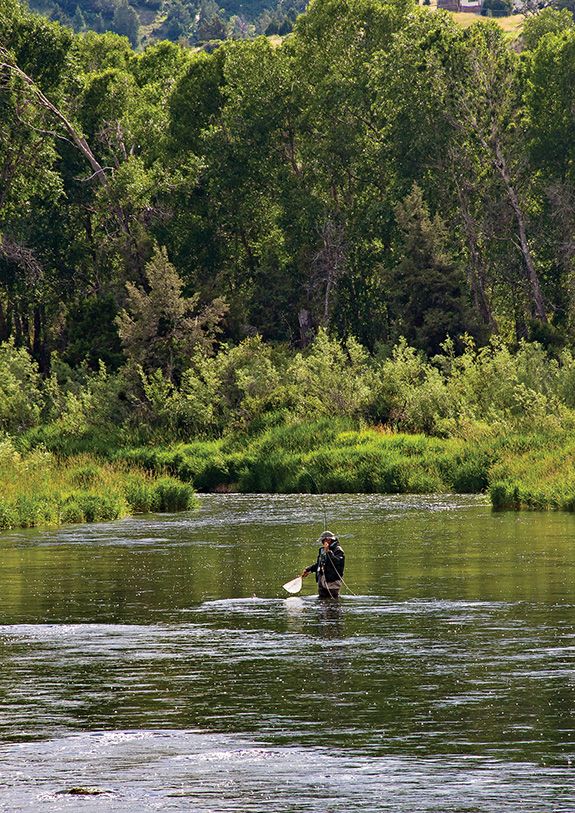
Depuy Spring Creek
Nelson’s Spring Creek
On a separate spring and property, across the Yellowstone River, you’ll find Nelson’s—small but mighty, with 3/4 of a mile of water that’s open year-round. There’s a lodge, fly shop, and guides for those visiting the area.
Sight-fishing is a big deal at Nelson’s. The fish spook easily and can be very picky about their food. Bring plenty of flies to match the hatch precisely, and change up your techniques. Pale morning duns and blue-winged olives are the prime focus in the spring. Indicators can be helpful, but keep them small. Polarized glasses are a must for spotting these sly monsters.
Like Depuy and Armstrong, Nelson’s charges $40 and $80 in the off-season—but their cutoff dates are two weeks earlier: March 31 and May 31.
O’Dell Spring Creek
On the other side of Bozeman, in the equally impressive Madison Valley, you’ll find O’Dell’s, a clear-flowing creek that offers extraordinary fishing opportunities as well as a rich history.
Situated just outside Ennis, below the west face of the Madison Range, the land surrounding the stream was a longtime cattle ranch that has since been restored to its original wetland habitat. Sixteen thousand feet of drainage ditches were filled, restoring nearly seven miles of stream channel and its surrounding habitat in what has been hailed as the largest restoration endeavor in Montana. The new channel structure improved streamflows and lowered the water temperature, which allows brown and rainbow trout to thrive.
Riffles, pools, and runs give anglers many opportunities to catch large, wary trout. Many of the fish stay close to the banks, especially in the colder months when they’re feeling lethargic.
Fly presentation is essential in luring trout from the banks. Some of the most popular flies include parachute Adams, red copper Johns, and hoppers in late spring and into summer. An on-site fly shop is available to help set you up for success.
O’Dell’s is managed by Rainbow Valley Lodge and allows four anglers on the water per day. If you’re interested in giving the creek a shot, make sure to call in advance, especially during hopper season. Rod fees are $60 per day, year-round.
Budtime Bugs: Spring flies for spring creeks and tailwaters.
Muddy spring runoff can seem to put fly fishing out of the question, but streamflow fluctuations are largely mitigated on southwest Montana’s tailwater and spring-fed fisheries. Due to their consistent sources, these environments often favor certain insects over others, thus some flies work better than others at these locations.
Scuds and Sowbugs
These freshwater crustaceans are available in large quantities in nutrient-rich tailwater and spring-fed waters, most significantly in those with extensive aquatic vegetation. They are especially important during the cold months and early spring, when aquatic insect activity is generally lower. Anglers should be prepared with scud patterns in sizes 14-18 in pink, grey, tan, and orange. There are plenty of commercially available patterns in our local fly shops for those who do not prefer to tie their own. Likewise, soft-hackled sow bugs sized 12-16 in similar colors can be effective—soft-hackled Ray Charles and rainbow Czech nymphs are great choices. Carrying flies in both beadhead and non-beaded versions allows you to cover any situation, from the deep-current seams and eddies of the Missouri to the shallow riffles and flats of Depuy Spring Creek that require little or no weight.
Midges
The venerable zebra midge (and variations) in sizes 16-18 should take up a good section of your midge box. I always carry them in black, red, and olive to imitate drifting pupae and larva. These little insects are available any month of the year, but heavy hatches are common in winter and spring. A Griffith’s gnat dry fly in larger sizes makes a great cluster imitation during these events. A smoke jumper or similar fly with CDC or an antron wing should work on fish selecting single insects or feeding in flat, slow water.
Worms/Annelids
It is hard to impress upon the spring fisherman the importance of the worm. Admittedly unglamorous, a San Juan worm is my first choice in any tandem-fly setup this time of year. I have found the most successful early-season colors to be pink, red, natural brown, and wine. It is common to find color preferences from one fishery to the next or even depending on the day, so it pays to carry a variety.
Baetis
A drifting Baetis nymph is a consistent and welcome food source for trout in spring creek and tailwater environments. Even the more mature and reclusive trout often move into feeding lanes to intercept this vulnerable prey. Be prepared with flashback pheasant tails, various lightning bugs, and little green machines in sizes 14-20. I always carry a supply of size 18 $3 dips. While designed on the upper Madison River, this versatile impression of an emerging insect catches fish anywhere and works wonders during the overlapping midge and baetis hatches. When the fish turn their attention to the surface, an olive sparkle dun or small olive soft hackle is hard to beat.
—Brady Hughes


